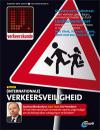Experts about (international) road safety
* George Robertson, Chairman, Commission for Global Road Safety * Max Mosley, Chairman, Global NCAP * Richard van den Hout, Advisor Public Affairs, ANWB
* José Viegas, General-Secretary, International Transport Forum IRTAD in Ibero-America
* Gérard Saillant, President, FIA Medical Commission / FIA Institute
* Thierry Willemarck, President FIA Region I
* Marc H. Juhel, Sector Manager Transport, WorldBank
* Wim van de Camp, Member of the European Parliament EVP/CDA
George Robertson, Chairman, Commission for Global Road Safety
Safer roads for all
‘Road crashes are a global epidemic, a preventable plague on the young and a major health and development burden. We are now 2 years into the UN Decade of Action for Road Safety 2011-2020. The launch of the Decade, and the 10 year campaign that preceded it, have succeeded in increasing awareness of road safety amongst governments and international institutions. But progress is too slow. There has been no overall reduction in road fatalities and many countries, including some leading economies, are still in denial about the extent of their road safety problem.
Over the next 2 years the international community will decide on the priorities that will replace the Millennium Development Goals and define the post-2015 sustainable development agenda. Road traffic injury prevention must be part of this framework.
It is now well past time for road traffic injury prevention to be included in the mainstream of efforts to improve global health, combat climate change and tackle inequality and poverty. The absence of road safety is one connecting symptom of all these 21st century challenges. Now, in the post-2015 debate, we have an unprecedented opportunity to build a wide and strong coalition committed to working together to make roads safe for all.’
More information about road safety
More information for parents about road safety
José Viegas, General-Secretary, International Transport Forum IRTAD in Ibero-America
Developing of sound crash data systems
‘The International Traffic Safety Data and Analysis Group (IRTAD) is a long-standing working group of the International Transport Forum on road safety data collection and analysis. It currently gathers road safety experts and statisticians from 35 countries. In 2008, the International Transport Forum – aware of the safety challenges in non-IRTAD countries and with the support of the World Bank Global Road Safety Facility – initiated the concept of twinning between an existing IRTAD country and potential new countries in order to assist those countries in developing sound crash data systems. The first IRTAD twinning occurred between Argentina and Spain. Its success initiated the desire for broader cooperation on road safety data collection and analysis in Ibero-America. In 2012, governments from 18 countries launched the Ibero-American Road Safety Observatory (OISEVI), supported by a regional road safety database designed on the basis of the ‘IRTAD LAC’ model. OISEVI and the IRTAD LAC database are a powerful tool to create a dynamic for road safety in Ibero-America, monitor progress in the region based on common safety indicators, and share best practices. IRTAD initiated several other twinning projects with partners, such as the World Bank, the Inter-American Development Bank, and the FIA Foundation, and could contribute to the creation of other regional observatories for road safety.’
More information: www.internationaltransportforum.org
Max Mosley, Chairman, Global NCAP
Popular cars sold today in many emerging markets are still about 20 years behind the European and North American safety levels
‘Consumer information has been a powerful driver of improved automobile safety over the last 30 years. Crash tests, carried out by New Car Assessment Programmes (NCAPs), have created a market for safety in which car buyers can choose much safer vehicles. In Europe, Euro NCAP – working closely with the FIA’s automobile clubs, including the ANWB – has transformed the safety performance of the car fleet. Five star cars are now available in all vehicle classes across the entire European Union. Yet in emerging markets, like Brazil, China, and India where automobile use is expanding at an unprecedented rate, we face a growing death toll on the road. In South America, for example, where the important vehicle safety regulations developed by the United Nations are not always applied, the most popular cars sold today are still about 20 years behind the levels of safety enjoyed in Europe and North America. We believe that consumer demand will grow for safer vehicles once car buyers are aware of the different levels of safety that can be available. Global NCAP is developing new programmes in rapidly motorising regions and providing a platform for co-operation among NCAPs worldwide. In this way we hope to make a significant contribution to the UN Decade of Action for Road Safety.’
More information: www.globalncap.org
Richard van den Hout, Advisor Public Affairs, ANWB
RAP: strength and weakness of road infrastructure expressed by coloured stars
‘Although The Netherlands are among the countries that have the safest traffic worldwide, still two people die in traffic every day on average, and several tens of people become heavily injured. Every day families are being struck by intense grief over their beloved not coming home anymore. Reason for ANWB to, in cooperation with other automobile clubs, map the risk of a severe accident using the Road Assessment Programme (RAP). With this approach the safety of road infrastructure for road users is systematically assessed. From my own experience, I can tell how an unsafe road design can make a difference between life and death within one second. Despite the complexity and solid scientific basis, the power of the Road Assessment Programme is in its simplicity. The strength and the weakness of the infrastructure are expressed by coloured stars. Stretches of road with just one star – black – have an elevated risk on very severe accidents, while roads with five stars – green – are safe. The programme offers road authorities information about which stretches of road need action first at a glance, and road users know on which roads they should be extra vigilant. It is worldwide rolled out in a uniform way, so when preparing for a holiday people can select a safe road.’
Meer information: www.eurorap.org and www.ausrap.org/ausrap/saferroads/
Gérard Saillant, President, FIA Medical Commission / FIA Institute
Safer roads, safer cars, safer drivers: what the FIA has learned from motorsport
‘Everyone knows that motor sports are dangerous. Inevitably there are limits to drivers’ skills, track conditions and the strength of materials. And for most people involved in the sport, whether they are drivers or engineers, pushing boundaries is the essence of life.In the aftermath of the tragic accidents at Imola and Monaco in 1994, the FIA developed a new philosophy and approach to motorsport safety. The FIA takes on the responsibility of ensuring that the system is as safe as possible and regulates international motorsport such that competitors may find the same standards for safety in all race-organising countries. The engineering of circuits, closed road rallies stages, hill climbs, and the cars and drivers’ equipment are all regulated and policed. Nowadays, a fatality in an international championship is a rarity.Motorsport safety can show what is possible if there are no constraints on the level of technology applied or on the costs involved. While the lessons learned cannot always be directly or economically applied to the road system, much of the data and experience gathered is relevant. Since the physics and physiology of an accident on the track are very similar to those of a road accident, motorsport provides an excellent environment for vehicle safety and track safety research.’
More information: www.fiainstitute.com
Thierry Willemarck, President FIA Region I
eCall by 2015 to save thousands of lives
‘All new, type-approved cars in Europe should have the emergency call ‘eCall’ system on board by 2015. That is the basis of a new European Commission proposal, published on 13 June 2013, which now needs the support of EU governments and the European Parliament. The move comes after many years of frustration and delay, but if accepted, should make a vital contribution towards improving road safety. By facilitating emergency services to provide assistance to vehicle drivers and passengers much more quickly, it is estimated the system could save up to 2,500 lives a year, as well as reduce the severity of injuries and trauma in tens of thousands of cases. The extensive use of eCall already today will allow for the system to be quickly improved and avoid false alerts that may have prevailed during the test phase. In addition, the technology mandated by eCall can support a range of extra’s such as breakdown assistance services, traffic information, stolen vehicle tracking and pay-as-you-go insurance schemes. In order to protect free competition and more choice for consumers, however, FIA Automobile Clubs have been campaigning to ensure this system is made available to service providers on the basis of an open platform. We have waited too long already for eCall, let’s support the 2015 target date, and not miss our chance to save thousands of lives every year.’
More information: www.fiaregion1.com
Marc H. Juhel, Sector Manager Transport, WorldBank
Road safety: ‘do not leave the vulnerable behind’
‘The World Bank’s overarching goal is to eradicate poverty while boosting shared prosperity. We know that mobility is critical to economic growth, but for mobility to bring about sustainable benefits to all it needs to be safe. The recent Global Burden of Disease Report has clearly identified lack of road safety as a major international health crisis. People killed or disabled by road accidents and their families suffer from a loss of wage earnings in countries where social safety nets are often non-existent. Over 90 percent of the crashes happen in the developing world, and cost between 1-3 percent in GDP loss on average. With the launch of the Global Road Safety Facility (GRSF) in 2006 as the first global technical fund for road safety, the World Bank took a decisive step to mainstream road safety considerations. Road projects benefiting from World Bank support have to systematically include a road safety perspective. We know that a long-term investment strategy is required to continuously improve national road safety performance. To help countries embark on this journey the GRSF developed several practical methodological tools, among which the Guidelines for Road Safety Management Capacity Reviews and Safe Systems Projects. The idea of this approach is that we want to move to a more inclusive, mobile society, one that does not leave the vulnerable behind.’
Wim van de Camp, Member of the European Parliament EVP/CDA
Advanced braking systems: a good measure in the context of road safety
‘Driving a motorcycle or a scooter involves certain risks. Two-wheeled vehicles are simply less stable and less visible than three- or four-wheeled vehicles. Also experience and regularity in riding such a vehicle play a major role. Various studies by German institutes like ADAC and DEKRA have shown that many – unilateral – accidents result from incorrect braking by the driver of the vehicle concerned. ‘Practice makes perfection’ is a well-known Dutch proverb; and frequent driving and braking practice is the first lesson. If you have never been in an unexpected situation with your bike or scooter, you are often unable to brake adequately or effectively. Panic braking often leads to accidents. In the meantime, however, advanced braking systems like Anti-lock Braking Systems (ABS) and Combined Braking Systems (CBS) are already available on the market. These systems dose the braking force of the motorcycle or scooter and distribute it over the front and rear wheel to prevent blocking of the rear wheel in particular. A blocked rear wheel inevitably leads to a crash. The same German studies show that two-wheeled vehicles equipped with ABS or CBS are much less involved in braking accidents. Hence, the European Union has decided to oblige ABS for motorcycles and heavy scooters as from 1 January 2016. A good measure in the context of road safety.’



Reactie plaatsen •